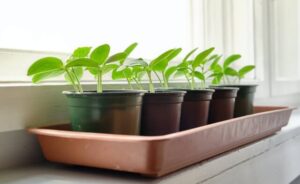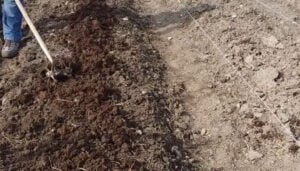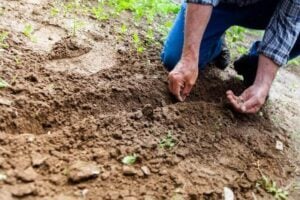In this article, you are going to learn how to grow plants from seeds step by step. This guide includes basic and advanced methods on how to plant seeds outdoor and indoors.
Let us jump right in.
In case you are in a rush, here is a short answer to the question:
- Select a good planting container
- Select good and fertile soil
- Prepare the potting mix
- Plant quality seeds
- Water timely
- Take care of the seedlings
- Acclimatize the seedlings before transplanting
Read on for a detailed step-by-step guide on how to start seeds indoors.
Select Good Planting Container
Choose the right container with a reasonable size. According to one study, while finding the effects of container size and type on the growth and quality of Indian Sandalwood seedlings, it was found that all the growth parameters were seen to grow well in the 600ml root trainer container when compared with the other 150ml, 270ml, 300ml, and 450ml root containers.
And this study clearly shows how the size of the container is important to growing healthy plants from seeds.
Ideally, the size of the container should be at least 2-3 inches deep with good holes underneath for draining water.
Moreover, the type of container is also an important factor that plays a major role during germination and seedlings growth.
The above study also compared three types of containers, which include root trainers, polythene bags, and plastic containers.
In this study, it was found that seeds of Indian sandalwood that were grown in root trainers outperformed seeds of Indian sandalwood that were grown in plastic containers and polythene bags in terms of survival and overall growth.
However, if you can’t afford to buy pots, trays, and other quality seed-starting containers, you can also sow your seeds in containers like polythene bags and plastic containers.
Moreover, before putting the starting mix, make sure the containers are cleaned by sterilizing them with a good disinfectant. This helps kill any diseased pathogens such as fungi, bacteria, algae, and viruses.
Select a Fertile Soil For your Starting Mix
You don’t want to fill up your seed-starting containers with poor soil such as sandy or clay soils. Find and buy a clean and germ-free potting soil mix.
It is not recommended to start seeds on the garden soil. This is because garden soil is very heavy and may contain diseased pathogens and weed seeds.
Always buy your seed-starting mix at your local stores such as garden centers or trusted online stores.
Related: What Are The Best Garden Seeds To Buy? The Ultimate Garden Seeds Buying Guide
Prepare the Potting Mix
Now that you have selected your seed-starting containers and you have also gotten your starting mix, it is time to prepare the mix and fill the seed-starting containers with soil mix. Soak the starting mix gently with water before adding to the containers.
Related: How to make compost at home step by step guide
Select Quality and Fertile Seeds
Do not plant low-quality seeds that will waste your time, energy, and money. Always choose good seeds before planting.
If you are just starting out or you don’t know how to choose quality seeds, you can refer yourself to our ultimate guide on how to select the best quality seeds.
Plant the Seeds
The planting of seeds in a starting container solely depends on the size of the seeds. Generally, most seeds come with an in-depth guide on how to sow them.
The problem is when you obtain the seeds from a random seller or source. In this case, seeds with small sizes are covered with small seed-starting mix soil while seeds that are large in size are usually covered with potting soil that is equal to three times their sizes.
Read also: How Does A Plant Grow Step By Step
Water Timely
If you bought a seed-starting kit, you don’t need to worry about overwatering and damping up. This is because most seed-starting tasks are provided and explained in the kits. You only need to follow the procedures without much calculations, measurements, estimations, and trial and error.
Reduce the Time of Germination
It is a good practice to employ some techniques that will help quicken the germination time and may include warming the starting containers.
It was found that seeds do not germinate fast when kept under cold conditions. Some seeds can even die up.
So, provide heat to the seed-starting containers using waterproof heating mats. This can help maintain the temperature that will favor qúicker germination. Basically, seeds require a temperature between the range of 70-75°F for proper germination.
Take Care of the Seedlings
When the seeds start sprouting, you need to give the seedlings enough light. Seedlings require at least 14-16 hours of direct light daily.
You can use direct sunlight. However, this may affect your seedlings if you are living in a sunny area. Instead, buy an artificial lighting machine, which was believed to be convenient.
You can get it on Amazon.
You also want to keep the starting containers moisten. This can help develop the root of the seedlings very well. But, do not overwater as this can cause damping up, which can kill your garden plants.
You also need to start fertilizing seedlings when you observe that the seedlings are growing leaves. Use half-strength liquid fertilizer after 8 days. When they are like 30 days old, you can begin to feed them with full-strength liquid fertilizer weekly And when you want to transplant them to the garden field.
Related: Learn how to prepare a garden spot
Acclimatize the Seedlings Before Planting
Do not just transplant your plants to the outdoor when you observe that they are ready to be planted outside.
At this time, the seedlings are too fragile to survive the harsh weather of the environment or open world. In this case, the seedlings need to be hardened or acclimatized.
Seedlings hardening is a technique whereby seedlings that were grown in a greenhouse or indoors are gradually introduced to the changing climatic conditions of the environment.
In this case, you need to bring out the seedlings to the direct sunshine, wind, relative humidity, and varying temperatures in the morning and then during the later afternoon through evening.
Tip: Learn more about seedling hardening from here and here
These are the steps for planting seeds indoors. Keep reading to find out how to plant seeds outdoor.
How to Plant Seeds Outdoor
Planting seeds indoors is one of the ways to grow plants from seeds. Another way for growing plants from seeds is to plant the seeds directly on the garden plot.
Here is the step by step guide about how to plant seeds outdoor:
- Prepare the garden spot
- Make holes for putting seeds
- Plant the seeds
- Water timely
- Take care of the new garden
Prepare the Garden Spot
Remove all grasses and weeds that may be present in the garden manually with hand or rake. Find a good rake and rake them up.
Use the rake to loosen the soil. Remove rocks, debris, and break large soil clumps into pieces. All these can help allow plant roots to grow well. Add compost and if you have money, you can add organic fertilizer to the soil.
Make Holes for Putting Seeds
After preparing the garden spot, design the layout of the garden plot into either formal rows or informal layout. Dig holes and put seeds.
Most of the seed companies usually explain how to keep the seeds to be planted. In general, seeds should be planted 3 times their size. Some seeds are good for broadcasting while other seeds are good in formal rows.
Whatever the case may be, always follow the instructions given on the seed package or ask your local gardeners that are growing that kind of seed.
Plant the Seeds
This is usually explained on the seed package. However, there are some seeds that do require light, and those seeds are usually planted by broadcasting. Put them on top of the garden and press down gently with the garden board.
Mix tiny seeds with sand( that is only if you are planting small seeds like carrots). This can help disperse the seeds evenly during planting.
Water Timely
When you finish planting, ensure that you moisten the garden soil gently with water. Avoid damping up. Keep the soil moisture relatively intact. This is because seeds require moisture to germinate properly.
When they started becoming seedlings, water the seedlings timely. This can help prevent the seedlings from wilting and dying up.
Take Care of Your New Garden
When the seeds sprout and started growing into a matured seedlings, you need to thin out the seedlings that are closely packed together to create proper space between plants. This can help promote the efficient passage of air and improve plant growth.
Weed the area of the garden when weeds and grasses started growing. This can help prevent the off-plants from competing with your garden plants against nutrients, sunlight, water, and space.
Weeding the grasses and weeds can also prevent pests from dominating your garden and also make your garden plants less susceptible to diseases.
Do not starve your plants with water. Irrigate the plants timely with sprays and do not overwater. Just ensure that the garden spot is always moist.
Feed your plants with both compost manure and inorganic fertilizer. Start with a soluble half-strength liquid fertilizer when the plants are just growing their leaves and later switch to full-strength soluble fertilizer when the seedlings are fully grown. (Learn more on how to take care of your garden)
Are you just starting a garden? Read our detailed beginner’s guide to gardening
Frequently Asked Questions
Can you grow Plants from fresh Seeds?
One effective way to reduce what you are spending on your pocket is to plant seeds that you grow and harvest from your garden. This can reduce cost and help you plant only true-to-types seeds.
However, planting seeds that are fresh is not recommended. This is because seeds need to be matured and rest before they can germinate properly.
How do you Grow Plants from Seeds Step by Step for Kids?
When you want to engage your kids in gardening activities especially during seed planting, you can place the seeds on the kids’ palms and ask them to use their fingers by pinching to place the seeds in the soil. Then, tell them to gently add some soil on top of the seeds.
How do You Prepare Seedlings for Planting?
Here is a step by step guide on how to prepare seedlings for planting:
- Fill a sterilized container with a potting mix if you want to grow your plants indoor
- Moisten the potting soil with water
- Arrange the seedlings on the container if you are growing indoor. And if you are growing on the garden plot, put them on the garden field after preparing the soil.
Which Plant Grows Fastest?
Below are some of the common plants that grow fast:
- Sunflower
- Cornflower
- Morning glories
What are the Easiest Seeds to Grow?
Below are some of the common seeds that grow easily:
- Pumpkins
- Peas
- Beans
Wrapping Up
If you are just a beginner at gardening, planting seeds and growing plants from seeds may sometimes be overwhelming. In this guide, I looked at the step by step guide on how to grow plants from seeds.
I hope the article was of excellent help to you in understanding how to plant seeds and grow them into plants. We would love to hear from you. So, do write to us in the comments section below.




